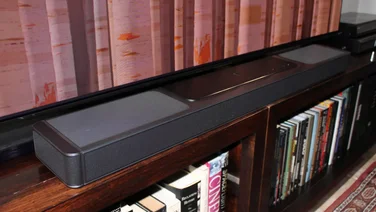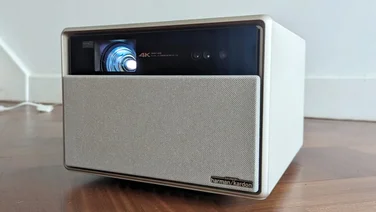To help us provide you with free impartial advice, we may earn a commission if you buy through links on our site. Learn more












The Sky Glass Air was teased at the same time Sky launched its Sky Glass Gen 2 TV in February 2025. Back then, all we knew about the new TV was that it was going to be cheaper than the flagship model, that it would run SkyOS like the original glass and that it would come without the Dolby Atmos soundbar.
Well, I’ve now had the chance to go hands-on with the new, cheaper Sky Glass TV, and I think it has a chance to expand Sky’s influence across UK living rooms and challenge rivals’ sales at the budget end of the market.
How much is Sky Glass Air?
So we’ve always known that the Sky Glass Air TV was going to be cheaper than its more exotic sibling, but not by how much. We weren’t sure, either, if Sky would offer to spread the cost of the TV in the same way, either.
In the end, the pricing looks highly competitive and, yes, you can still spread the cost over 24 or 48 months if you want. In fact, paying monthly for your Sky Glass Air actually makes the TV cheaper in the long run.
As with the Sky Glass Gen 2, the Sky Glass Air TV is available in three sizes: 43in, 55in and 65in and here’s the cost breakdown:
Sky Glass Air prices
| 43in | |
|---|---|
| Up front | £309 |
| Monthly price over 24 months | £12 |
| Monthly price over 48 months | £6 |
| 55in | |
|---|---|
| Up front | £509 |
| Monthly price over 24 months | £20 |
| Monthly price over 48 months | £10 |
| 65in | |
|---|---|
| Up front | £649 |
| Monthly price over 24 months | £26 |
| Monthly price over 48 months | £13 |
At those prices, the Air is pretty competitive. In all sizes, it’s cheaper than the latest range of Amazon Fire 4-series TV models were at launch. At the time of writing, however, the prices of the latter have taken a big tumble, at a mere £280 for the 43in and £370 for the 55in model.












As for availability, you’ll be able to order one from 10 June 2025 from either the Sky website or Currys with units shipping straight away. And don’t forget you’ll also need to add the cost of a Sky subscription to the above prices, but that’s not too pricey, with the cheapest bundle kicking off from £15 per month for Sky Essential TV.
What you won’t have to do is factor in the installation of a satellite dish; just like the Glass TV and the Sky Stream set-top box, the Sky Glass Air uses Sky’s entirely internet-driven TV streaming system, Sky OS.
Sky Glass Air vs Sky Glass Gen 2
The main difference, then, between the new Sky Glass Air and the Gen 2 is the price and it’s not a small difference at that. Taking the 43in model as an example, in fact, it’s less than half the price of the equivalent Glass Gen 2, which is £699 if you pay up front, or from £14 per month if you pay over 48 months.












Naturally, though, there are some concessions to make in exchange for such a big price cut, and the biggest of these is that you don’t get a soundbar built in. Instead of a multi-driver Dolby Atmos-enabled integrated soundbar, the Sky Glass Air’s audio system consists of a simple pair of stereo drivers, designed to fire downwards from the bottom edge of the TV.
The audio this produces isn’t bad – in a demonstration at a preview event organised by Sky, I thought there was plenty of volume and clarity – but it does lack warmth and low end, as you would expect from a system lacking a subwoofer.












That needn’t be a problem. In fact, it may actually be preferable if you already own a sound bar or have a simple surround sound audio system in place. What you may not want to compromise on is image quality, and on this front the Sky Glass Air TV makes rather more compromises.
Instead of employing a full-array local dimming backlight, which is able to adjust the backlight in zones, depending on the brightness or lack thereof in certain parts of the image, the Air makes use of what Sky is calling global dimming.
Known more commonly as direct LED backlighting, this uses an array of LEDs to light the rear of the TV’s LCD, but it can’t be adjusted in zones, meaning the background black level will probably look a little on the grey side compared with the Gen 2. The refresh rate of the TV is limited to 60Hz, too, so owners of next-gen consoles looking to make the most of their hardware will probably want to look elsewhere.












The good news, though, is the Sky Glass Air’s 4K VA panel utilises a quantum dot filter, so it should be capable of delivering a decent spread of colours (hopefully better than the non-quantum dot Amazon Fire TV models).
On most other counts, the Sky Glass Air is a match for its pricier sibling. It runs Sky OS, so you get access to all the same content and well-designed UI as you do on the more expensive TV. It has far-field microphones, so you can control it with your voice without having to press a button on the microphone. And it has three HDMI inputs on the rear, one of which is eARC enabled.
The Sky Glass Air even looks like a Sky Glass Gen 2, its low-slung central stand lending it an elegant, modern look that eludes much of the budget competition. And although the chassis is mostly constructed from plastic, the fact that it’s available in three different colours – grey, white and “sea green” – means it looks more sophisticated than most in this price range.












The only other things you miss out on are the motion sensor – so it won’t turn on when you walk into the room like the Gen 2 (that’s a feature I usually turn off, anyway) – and compatibility with Sky’s motion tracking Live camera system.
Sky Glass Air TV: Early verdict
It’s a little early to say how good or bad the Sky Glass Air TV is at this juncture. I’ll deliver my final verdict once I’ve had the opportunity to fully test the new TV and use it to watch my favourite shows and movies.
But for now, it looks like the Sky Glass Air gets a lot of things right. It’s affordable, doesn’t come burdened with the unnecessary baggage of a built-in Dolby Atmos soundbar and yet it delivers the same dish-free convenience of the (much) more expensive Sky Glass Gen 2. Hopefully the panel can deliver on picture quality as well.






